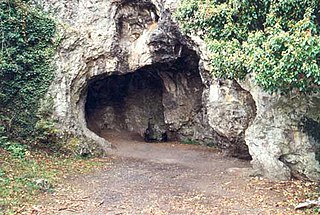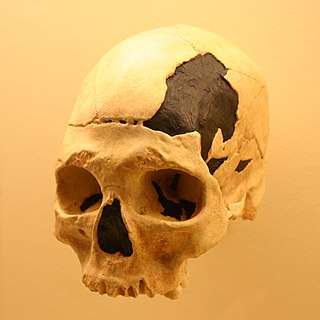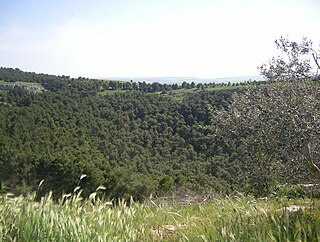
Paleogenetics is the study of the past through the examination of preserved genetic material from the remains of ancient organisms. Emile Zuckerkandl and Linus Pauling introduced the term in 1963, long before the sequencing of DNA, in reference to the possible reconstruction of the corresponding polypeptide sequences of past organisms. The first sequence of ancient DNA, isolated from a museum specimen of the extinct quagga, was published in 1984 by a team led by Allan Wilson.

Ceprano Man, Argil, and Ceprano Calvarium, is a Middle Pleistocene archaic human fossil, a single skull cap (calvarium), accidentally unearthed in a highway construction project in 1994 near Ceprano in the Province of Frosinone, Italy. It was initially considered Homo cepranensis, Homo erectus, or possibly Homo antecessor; but in recent studies, most regard it either as a form of Homo heidelbergensis sharing affinities with African forms, or an early morph of Neanderthal.

Altamura is a town and comune of Apulia, in southern Italy. It is located on one of the hills of the Murge plateau in the Metropolitan City of Bari, 45 kilometres southwest of Bari, close to the border with Basilicata. As of 2017, its population amounts to 70,595 inhabitants.

Spy Cave is located in Wallonia near Spy in the municipality of Jemeppe-sur-Sambre, Namur Province, Belgium above the left bank of the Orneau River. Classified as a premier Heritage site of the Walloon Region, the location ranks among the most significant paleolithic sites in Europe. The cave consists of numerous small chambers and corridors.

The Parco Nazionale dell'Alta Murgia is a national park in Apulia, southern Italy, established in 2004. It lies in the Murgia geographical area, with its headquarters in the town of Gravina in Puglia, and has an area of 677.39 square kilometres. It is part of a larger Special Protection Area established to protect the grass steppe, lesser kestrel's habitat.

Feldhofer 1 or Neanderthal 1 is the scientific name of the 40,000-year-old type specimen fossil of the species Homo neanderthalensis, discovered in August 1856 in a German cave, the Kleine Feldhofer Grotte, in the Neandertal valley, 13 km (8.1 mi) east of Düsseldorf. In 1864, the fossil's description was first published in a scientific magazine and officially named. Neanderthal was not the first Neanderthal fossil discovery. Other Neanderthal fossils had been discovered earlier, but their true nature and significance had not been recognized, and, therefore, no separate species name was assigned.

Peștera cu Oase is a system of 12 karstic galleries and chambers located near the city Anina, in the Caraș-Severin county, southwestern Romania, where some of the oldest European early modern human (EEMH) remains, between 42,000 and 37,000 years old, have been found.

The Altopiano delle Murge is a karst topographic plateau of rectangular shape in southern Italy. Most of it lies within Apulia and corresponds with the sub-region known as Murgia or Le Murge. The plateau lies mainly in the Metropolitan City of Bari and the province of Barletta-Andria-Trani, but extends into the provinces of Brindisi and Taranto to the south, and into Matera in Basilicata to the west. The name is believed to originate from the Latin murex, meaning "sharp stone".

Guido Barbujani is an Italian population geneticist, evolutionary biologist and literary author born in Adria, who has worked with the State University of New York at Stony Brook (NY), University of Padua, and University of Bologna. He has taught at the University of Ferrara since 1996.
The Sidrón Cave is a non-carboniferous limestone karst cave system located in the Piloña municipality of Asturias, northwestern Spain, where Paleolithic rock art and the fossils of more than a dozen Neanderthals were found. Declared a "Partial Natural Reserve" in 1995, the site also serves as a retreat for five species of bats and is the place of discovery of two species of Coleoptera (beetles).

The Denisovans or Denisova hominins(di-NEE-sə-və) are an extinct species or subspecies of archaic human that ranged across Asia during the Lower and Middle Paleolithic, and lived, based on current evidence, from 285 to 52 thousand years ago. Denisovans are known from few physical remains; consequently, most of what is known about them comes from DNA evidence. No formal species name has been established pending more complete fossil material.

Denisova Cave is a cave in the Bashelaksky Range of the Altai mountains, Siberian Federal District, Russia. The cave has provided items of great paleoarchaeological and paleontological interest. Bone fragments of the Denisova hominin originate from the cave, including artifacts dated to around 40,000 BP. Remains of a 32,000-year-old prehistoric species of horse have also been found in the cave.

The Skhul and Qafzeh hominins or Qafzeh–Skhul early modern humans are hominin fossils discovered in Es-Skhul and Qafzeh caves in Israel. They are today classified as Homo sapiens, among the earliest of their species in Eurasia. Skhul Cave is on the slopes of Mount Carmel; Qafzeh Cave is a rockshelter near Nazareth in Lower Galilee.
Mezmaiskaya Cave is a prehistoric cave site overlooking the right bank of the Sukhoi Kurdzhips in the southern Russian Republic of Adygea, located in the northwestern foothills of the North Caucasus in the Caucasus Mountains system.

Okladnikov Cave is a paleoanthropological site located in the foothills of the Altai Mountains in Soloneshensky District, Altai Krai in southern Siberia, Russia. The cave faces south and is located on a Devonian karst escarpment, lying about 14 metres (46 ft) above the left bank of the Sibiryachikha River valley below; the river itself is a tributary of the Anuy River.

Pulo di Altamura is a doline located on the Murge plateau. It is the largest doline in that region and it is located about 6 kilometers (3.7 mi) north-west of the city of Altamura. It shares the local toponym pulo with other large dolines of the region, i.e. Pulicchio di Gravina, Pulo di Molfetta and Pulicchio di Toritto.

Pulicchio di Gravina is the second-largest doline in the Murge plateau after Pulo di Altamura. It falls into the territory of Gravina in Puglia, located about 10 kilometers (6.2 mi) north of the latter, close to the border with Altamura's territory. It shares the local toponym pulo with other large dolines of the region, i.e. Pulo di Altamura, Pulo di Molfetta and Pulicchio di Toritto.
















